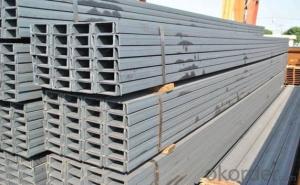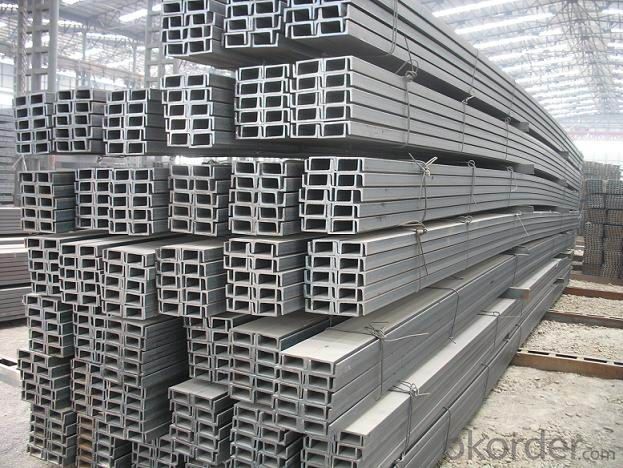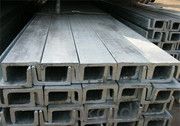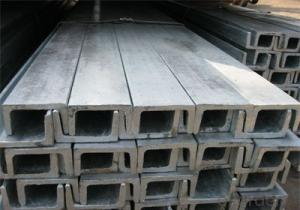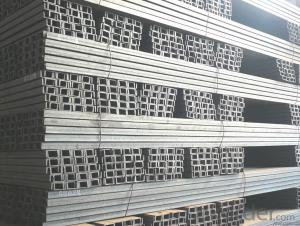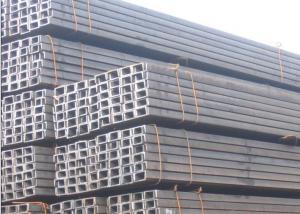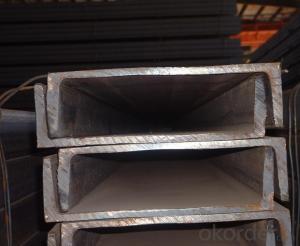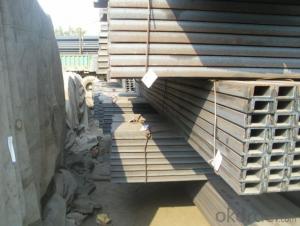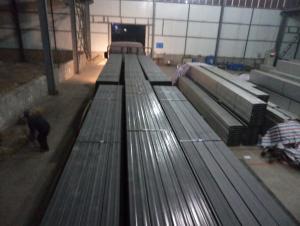Speical Used Steel U Channel With Higher Yield Point
- Loading Port:
- Tianjin
- Payment Terms:
- TT or LC
- Min Order Qty:
- 25 m.t.
- Supply Capability:
- 1000 m.t./month
OKorder Service Pledge
OKorder Financial Service
You Might Also Like
Description
In the production of steel products, steel is molded and reshaped with different machinery at different temperatures. One process is steel rolling, which involves metal stock passing through a pair of rolls. Rolling produces flat steel sheets of a specific thickness, and the process is classified according to the temperature at which the metal is rolled. If the temperature of the metal is above its recrystallization temperature, or the temperature at which the grain structure of the metal can be altered, then the process is termed as hot rolling. If the temperature of the metal is below its recrystallization temperature, the process is termed as cold rolling.
Like cold rolling, cold drawing is performed at room temperature, but instead of producing a flat object like a coke can, cold drawing makes steel into the form of a wire like the spokes of a wheel or a paper clip. To start the process, Steel is usual hammered and rolled so that it can be fit through a die; a tool that turns the steel mass into a wire. The room temperature steel is pulled through the die which reshapes it into a thinner shape while maintaining the same volume. It is similar to the idea of syrup flowing out of a bottle through a tube in that it changes shape but not volume, but instead of squeezing the metal, it is pulled out. In order to get the wire down to the right diameter, it usually requires more than one pass through different dies.
Chemical Compostion
Grade | Element(%) | |||
C | Mn | P | S | |
SS330 | -- | -- | ≦0.050 | ≦0.050 |
SS400 | ||||
SS490 | ||||
SS540 | ≦0.30 | ≦1.60 | ≦0.040 | ≦0.040 |
Usage/Applications
Channel Steel is usually used for building structure, vehicle manufacturing and other industrial structure and often used with i beam.
In details, the channel steel belongs to carbon structural steel which is applied to in the field of construction and machinery. The channel steel is usually used for arch-itechtural structure, and they could be welded in order to support or hang a vari-ety of facilities. They are also usually used in combination with I beam. Generally,the channel steel must possess perfect welding property, riveting property and mechanical property and so on.
FAQ:
Q1: Why buy Materials & Equipment from OKorder.com?
A1: All products offered byOKorder.com are carefully selected from China's most reliable manufacturing enterprises. Through its ISO certifications, OKorder.com adheres to the highest standards and a commitment to supply chain safety and customer satisfaction.
Q2: How do we guarantee the quality of our products?
A2: We have established an advanced quality management system which conducts strict quality tests at every step, from raw materials to the final product. At the same time, we provide extensive follow-up service assurances as required.
Q3: Can stainless steel rust?
A3: Stainless does not "rust" as you think of regular steel rusting with a red oxide on the surface that flakes off. If you see red rust it is probably due to some iron particles that have contaminated the surface of the stainless steel and it is these iron particles that are rusting. Look at the source of the rusting and see if you can remove it from the surface.
Q4: What makes stainless steel stainless?
A4: Stainless steel must contain at least 10.5 % chromium. It is this element that reacts with the oxygen in the air to form a complex chrome-oxide surface layer that is invisible but strong enough to prevent further oxygen from "staining" (rusting) the surface. Higher levels of chromium and the addition of other alloying elements such as nickel and molybdenum enhance this surface layer and improve the corrosion resistance of the stainless material.

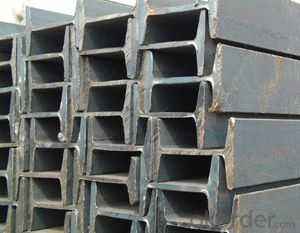
- Q: In the steel structure of steel purlin 160*60*20*2.5 is what mean
- Steel structure is mainly made of steel material, and it is one of the main types of building structure. The structure is mainly composed of steel beams and steel plates, such as steel beams, steel columns, steel trusses and so on. Each component or component is usually connected with welds, bolts or rivets. Because of its light weight and simple construction, it is widely used in large factories, stadiums, super high-rise and other fields.
- Q: Can steel channels be used for supporting canopies and awnings?
- Yes, steel channels can be used for supporting canopies and awnings. Steel channels provide a strong and sturdy support system that can handle the weight and stress of the canopy or awning. They are often used in construction and engineering projects for their durability and load-bearing capabilities.
- Q: How do steel channels contribute to the overall strength of a building?
- Steel channels contribute to the overall strength of a building in several ways. Firstly, steel channels provide structural support by distributing the load evenly across the building's framework. This helps to prevent the building from collapsing under its own weight or external forces such as wind or earthquakes. Secondly, steel channels are often used in the construction of walls, floors, and roofs to provide reinforcement and increase the rigidity of the building. By adding steel channels to these structural elements, the overall strength and stability of the building are enhanced, reducing the risk of structural failure. Furthermore, steel channels can be used as lintels or beams to support heavy loads, such as in bridges or multi-story buildings. Their high strength-to-weight ratio makes them ideal for such applications, as they can withstand significant amounts of load without deforming or failing. Additionally, steel channels contribute to the overall strength of a building by enhancing its resistance to fire and heat. Steel has a high melting point, which means that it can withstand high temperatures for longer periods compared to other building materials. This property helps to prevent structural collapse during a fire, giving occupants more time to evacuate and firefighters more time to control the blaze. In summary, steel channels play a vital role in enhancing the overall strength of a building by providing structural support, reinforcement, load distribution, and fire resistance. Their versatility and high strength-to-weight ratio make them an essential component in modern construction, ensuring the durability and safety of buildings.
- Q: Can steel channels be used in airport construction?
- Indeed, airport construction can make use of steel channels. Thanks to their robustness, endurance, and versatility, steel channels are frequently employed in construction ventures. In the realm of airport construction, steel channels find multiple uses, including serving as structural support, framing, and even forming walkways and platforms. Moreover, they can be utilized in manufacturing airport equipment and fixtures. Steel channels offer a financially viable option for airport construction due to their ease of fabrication and installation. Furthermore, their resistance to corrosion and ability to bear heavy loads make them an ideal fit for the rigorous demands of airport infrastructure.
- Q: Can steel channels be used for creating support structures for electrical systems?
- Yes, steel channels can be used for creating support structures for electrical systems. Steel channels are commonly used for their strength and durability, making them ideal for providing structural support to electrical wiring, conduits, and equipment. They can be easily customized and installed to accommodate the specific needs of electrical systems, ensuring stability and safe operation.
- Q: Do steel channels have any specific deflection limitations?
- Yes, steel channels do have specific deflection limitations. The deflection of any structural member, including steel channels, is determined by factors such as the material properties, dimensions, and the applied loads. The maximum allowable deflection for steel channels is typically specified in building codes and industry standards. These limitations are based on the criteria of serviceability, which ensure that the structure remains functional and safe under normal operating conditions. The deflection limits for steel channels vary depending on the specific application and loading conditions. For example, in structural steel design, the deflection limits for beams and columns are typically based on the span-to-depth ratio or a maximum allowable deflection value. In addition to code requirements, engineers also consider the intended use, aesthetics, and occupant comfort when determining deflection limitations. For instance, in buildings where vibrations or excessive deflections could impact sensitive equipment or occupant comfort, stricter deflection criteria may be applied. It is important to consult the relevant building codes, industry standards, and engineering guidelines to determine the specific deflection limitations for steel channels in a given application. Professional structural engineers are responsible for ensuring that the design meets these requirements to ensure the safety and performance of the structure.
- Q: Can steel channels be used in seismic design?
- Yes, steel channels can be used in seismic design. Steel channels are commonly used in seismic design to provide structural support and resist lateral forces that occur during an earthquake. They offer excellent strength and ductility, making them suitable for withstanding the dynamic loads and displacements experienced during seismic events. Additionally, steel channels can be easily fabricated and connected, allowing for efficient construction and flexibility in design.
- Q: How do steel channels contribute to LEED certification?
- There are multiple ways in which LEED certification can be achieved through the utilization of steel channels. Firstly, steel is a highly sustainable material due to its recyclability and ability to be utilized in various construction projects, thus reducing the need for new materials. This aligns with the LEED principle of waste minimization and resource efficiency. Furthermore, steel channels can be manufactured with a significant percentage of recycled content, thereby earning points towards LEED certification in the Materials and Resources category. By using recycled steel channels, the extraction and processing of raw materials are reduced, resulting in a lower carbon footprint and less environmental impact. Moreover, steel channels contribute to energy efficiency in buildings. This is due to their excellent thermal conductivity, which allows for efficient heat conduction. Architects and designers can incorporate steel channels into building designs, thereby enhancing the overall energy performance of the structure. One example is the utilization of steel channels in radiant heating and cooling systems, which improves energy efficiency and reduces reliance on traditional HVAC systems. Additionally, steel channels provide structural integrity to buildings, ensuring long-term durability and resilience. This reduces the need for frequent repairs or replacements, leading to a lower environmental impact and reduced waste generation over the lifespan of the building. To conclude, steel channels offer sustainable attributes such as recyclability, high recycled content, energy efficiency, and long-term durability, all of which contribute to LEED certification. By incorporating steel channels into construction projects, builders and designers can contribute to a more environmentally friendly and sustainable built environment, aligning with the goals and principles of LEED certification.
- Q: What's the name of channel steel?
- Channel steel is divided into ordinary channel steel and light channel steel.Again: according to different shapes, they can be divided into 4 kinds: cold bending equilateral channels, cold-formed non equilateral channel steel, cold rolled edge channels, the cold bending edge channels.
- Q: Can steel channels be used for curtain wall framing?
- Yes, steel channels can be used for curtain wall framing. Steel channels are often used in curtain wall systems for their strength and durability. They provide structural support and are able to withstand the load and pressure from the curtain wall system. Steel channels are versatile and can be designed to fit the specific requirements and dimensions of the curtain wall. Additionally, steel channels can be easily fabricated and installed, making them a popular choice for curtain wall framing.
Send your message to us
Speical Used Steel U Channel With Higher Yield Point
- Loading Port:
- Tianjin
- Payment Terms:
- TT or LC
- Min Order Qty:
- 25 m.t.
- Supply Capability:
- 1000 m.t./month
OKorder Service Pledge
OKorder Financial Service
Similar products
Hot products
Hot Searches
Related keywords
